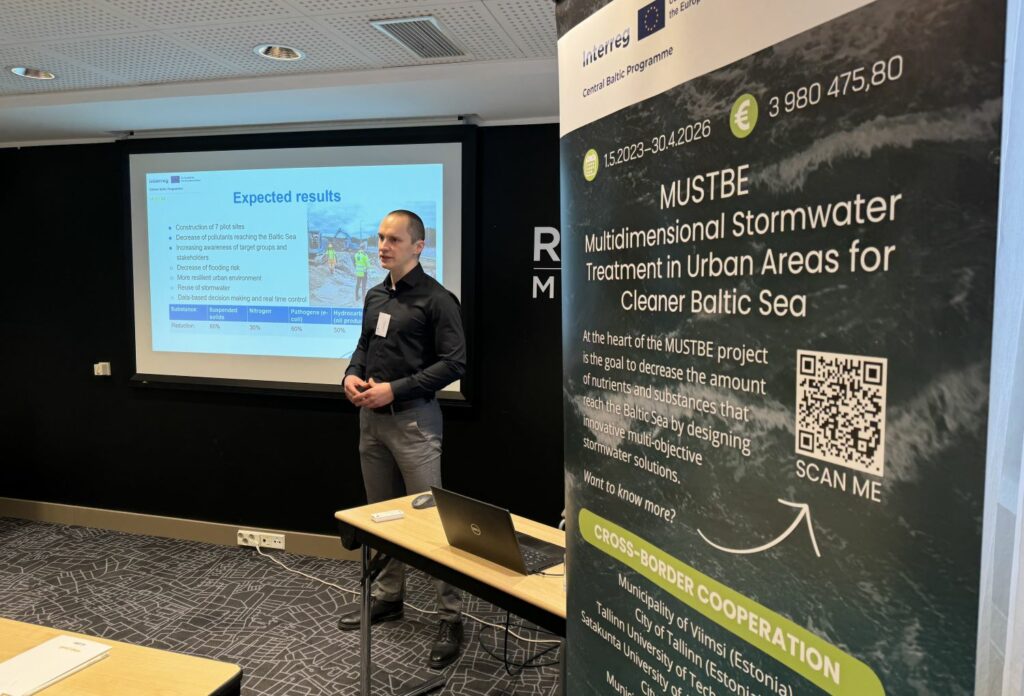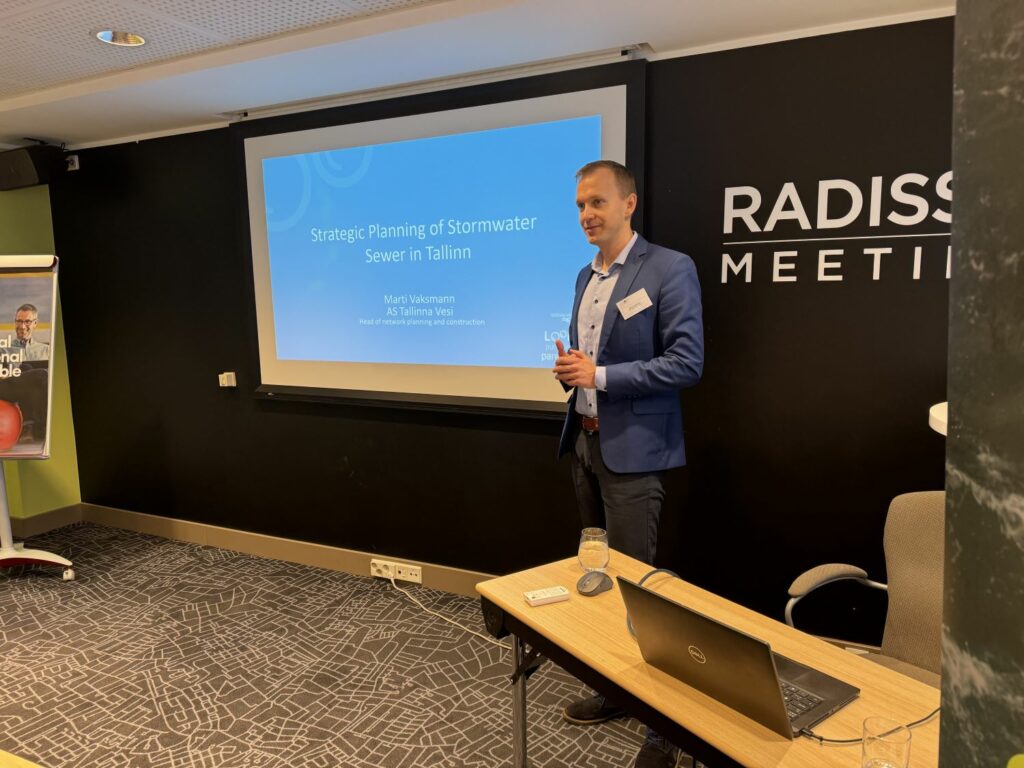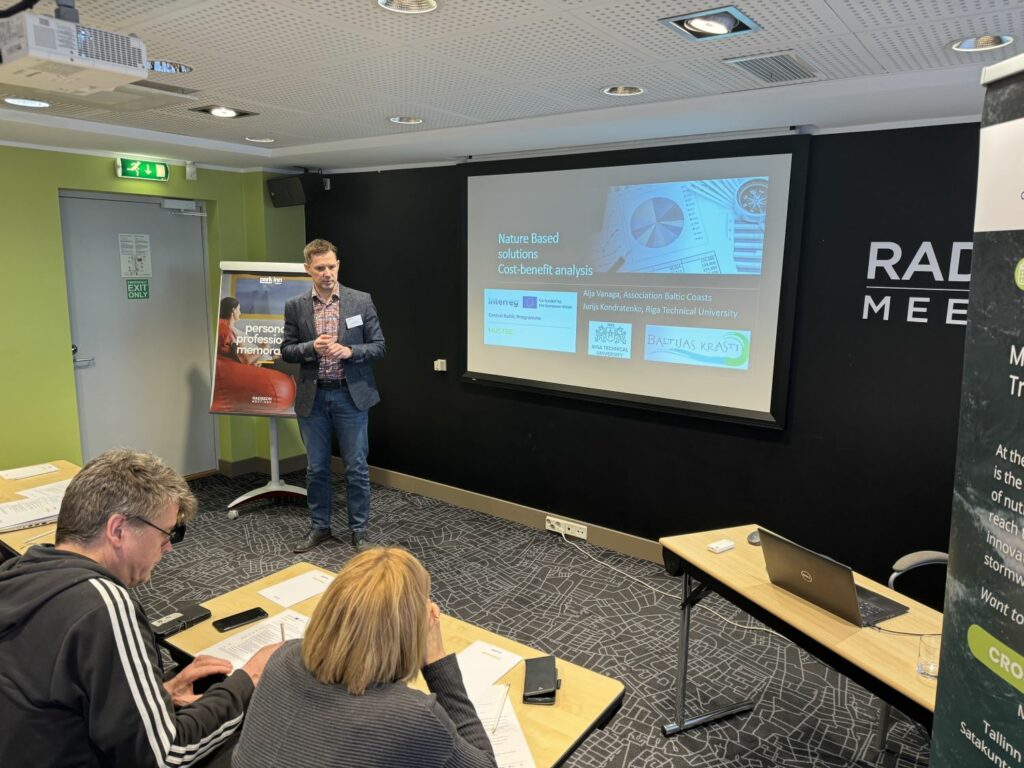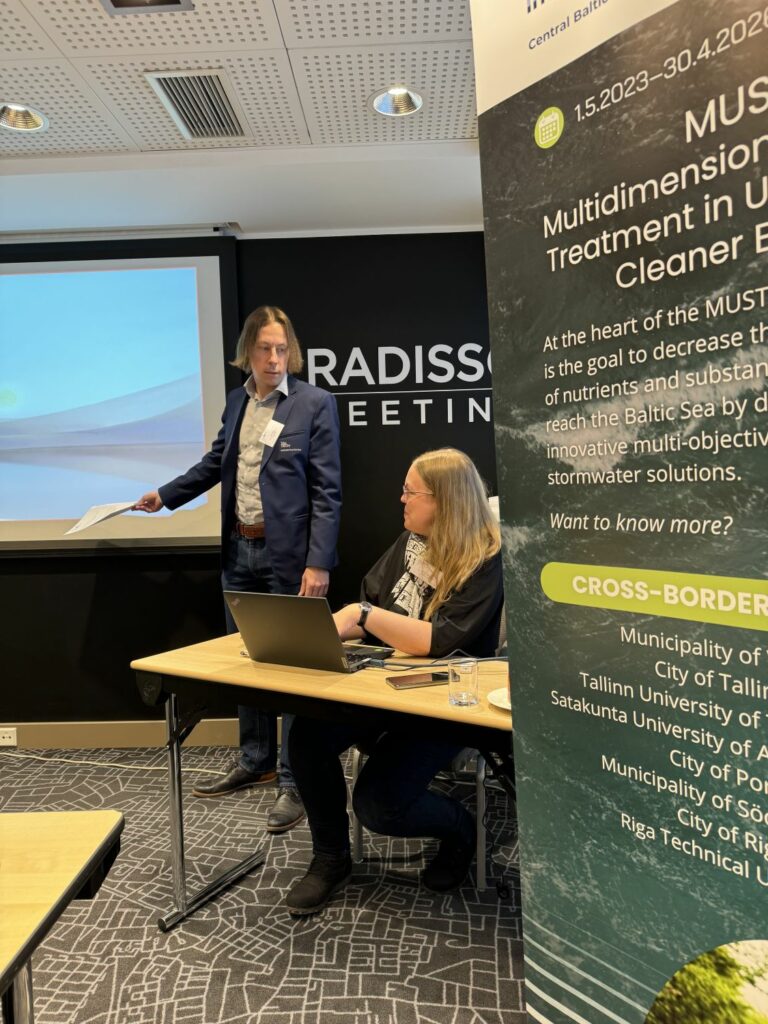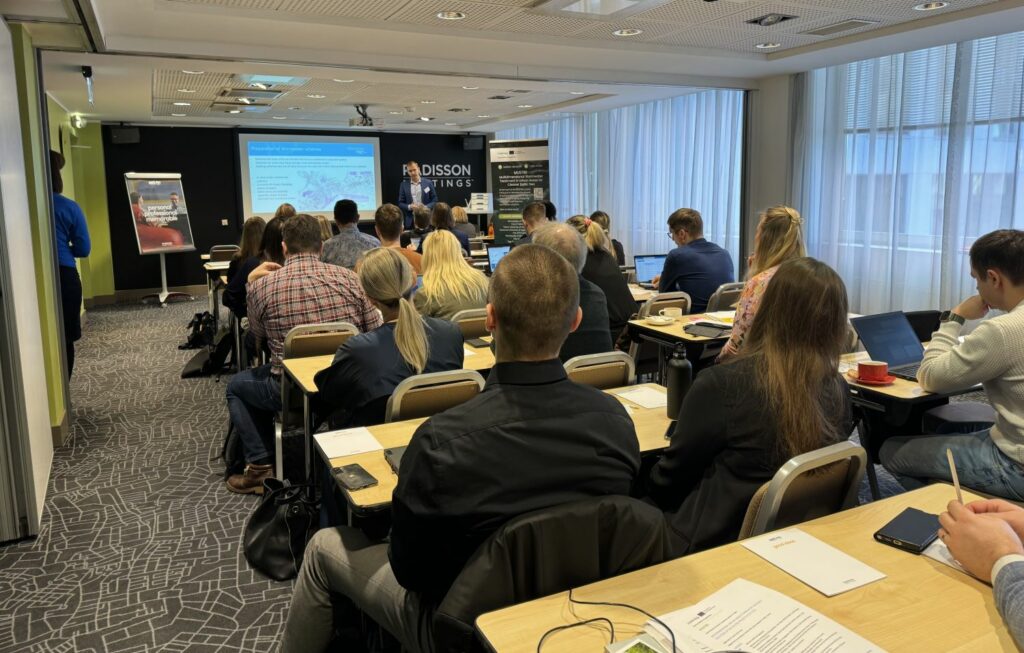Valuable Insights into Stormwater Solutions Presented at MUSTBE Seminar
MUSTBE is almost a one-year-old project. Its first year set the baseline for two important goals: development of digital and technical solutions to innovate urban stormwater management and awareness raising among stakeholders in the Baltic Sea region on how urban stormwater management can be improved to reduce discharges of excess nutrients and hazardous substances.
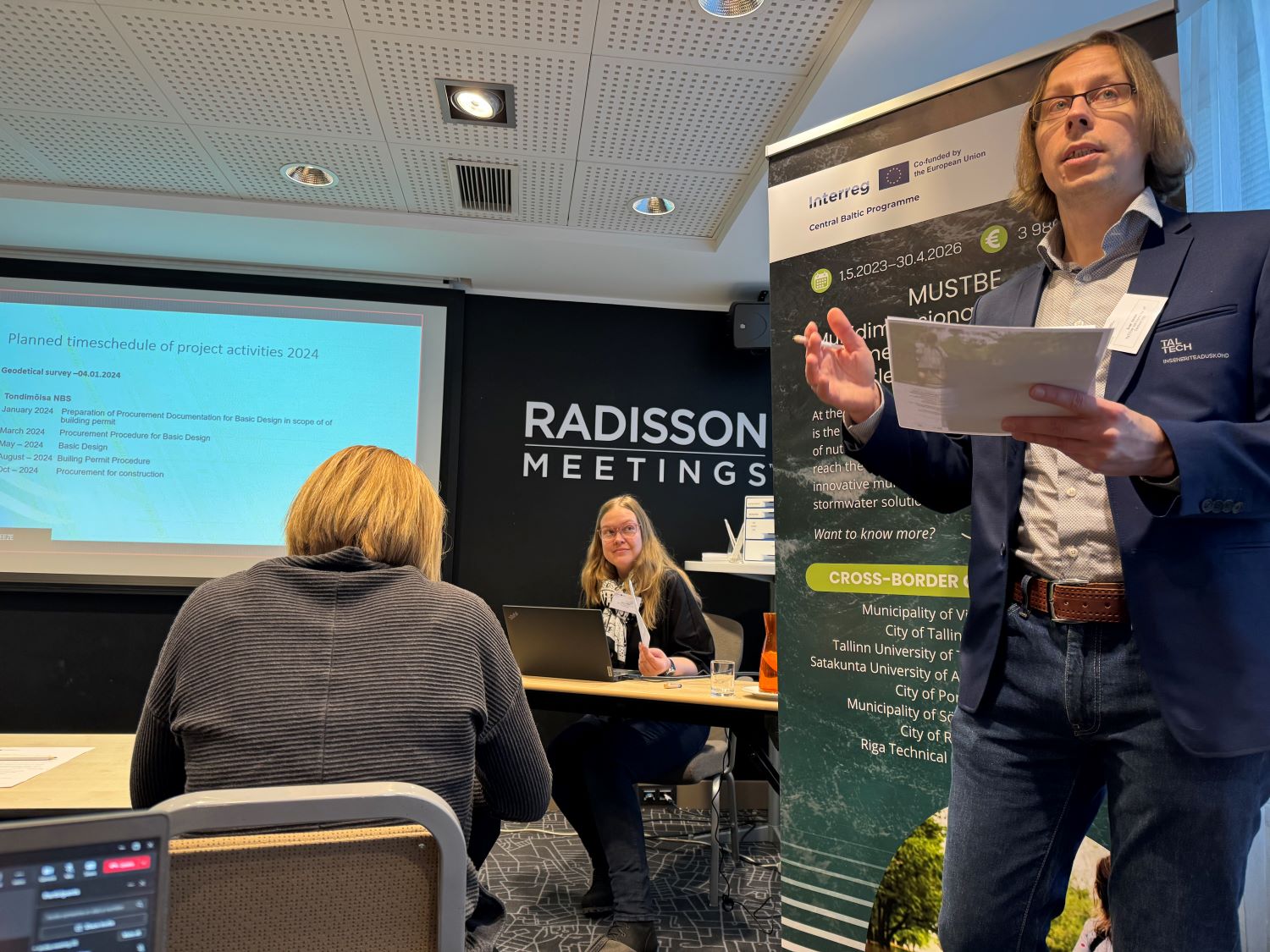
As knowledge exchange with stakeholders is an important aspect of the project, MUSTBE has planned several international face-to-face events in the four countries involved in the project, i.e. in Finland, Estonia, Sweden, and Latvia. The first cross-border event was held early March in Tallinn, Estonia. The seminar consisted of versatile presentations from the project partners and external leading experts in fields relevant to the project.
In his opening presentation the Lead Project Manager Siim Reinla from Viimsi municipality explained the three basic phases of the project: first analyse and design, then installation and construction, and finally monitoring and evaluation against the baseline conditions established by measurements and analysis in the first stage. In terms of water quality, the developed pilot solutions are expected to achieve pollutant reduction goals tentatively defined in the initiation phase of the project (60% suspended solids, 30% total nitrogen, 60% pathogens, 50% oil products, 40% metals, with specific values varying between pilot areas).
As the project aims to further achieve the most efficient land use and minimise conflicts between stakeholders, assessing the success of pilot solutions and, therefore, the project itself becomes a multi-objective analysis task. In other words, the solutions need to be multidimensional. Different aspects from costs to co-benefits and services provided should be considered in addition to pollutant reduction goals.
Meri-Maaria Salo, Researcher at Satakunta University of Applied Sciences, explained shortly the concept of multidimensionality as well as the planned solutions of the seven pilot sites. To achieve the aims, the project will install interventions in the form of smart nature-based stormwater system units. Two of the MUSTBE pilot sites are in Pori, Finland, one each in Tallinn and Viimsi, Estonia, two in Söderhamn, Sweden, and one in Riga, Latvia. The pilot sites vary in terms of their environment, catchment area, and the specific challenges they are designed for. The primary objectives the NBS are planned for are related to stormwater quality and quantity. Some pilots focus specifically on mitigating stormwater induced flooding risks by reducing peak flows in the area, while others focus on improving the quality of stormwater runoff. Specific MUSTBE pilot examples include dealing with contaminants originating from road traffic by catching the first flush flows and mitigating acid sulphate soil impacts by urban wetland restoration, runoff filtration and real-time monitoring activities. It is noteworthy that efforts to control quantity and improve quality are not mutually exclusive in terms of the solution design.
Good Planning Necessitates Good Cooperation
Two invited speeches were given by key stakeholders of the project. Marti Vaksmann, Head of Network Planning and Construction at AS Tallinna Vesi, and Kristiina Kupper, City Landscape Architect at Tallinn Urban Environment and Public Works Department. Mr. Vaksmann spoke about strategic planning of stormwater sewer in Tallinn, activities to map areas prone to flooding, competing interests of different stakeholders in urban space and also about cooperation between different stakeholders to better sustain the functionality of urban space in the course of infrastructure works. Ms. Kupper elaborated the environmental greenery aspects in designing and constructing innovative solutions, brought examples of solutions where a synergy has been achieved between existing ecosystem and new developments, and discussed how on the one hand from the city’s perspective green areas should provide mitigation on flooding and heat islands, and enhance biodiversity, i.e. be multidimensional, while on the other hand existing preservation plans sometimes tend to support monofunctional green spaces.
Tools for assessing nature-based solutions’ benefits
The morning session ended with a presentation given by Jurijs Kondratenko from Riga Technical University on cost-benefit analysis of nature-based solutions (NBS). He referred to Cohen-Sachman (2016) definition of nature-based solutions: “actions to protect, sustainably manage, and restore natural or modified ecosystems, that address societal challenges effectively and adaptively, simultaneously providing human well-being and biodiversity benefits”. Kondratenko discussed NBS assessment tools and illustrated the wide flexibility in assessing co-benefits in the framework of costs while also reiterating that the goal in MUSTBE would be to quantify the effects and calculate specific values. His presentation underlined that the choice of method to assess a nature-based solution needs to be justified by the purpose. To identify least-cost alternatives to achieve a single goal, the “cost-effectiveness analysis” approach is suitable. For assessing the economic feasibility and potential benefits of an intervention the “cost-benefit analysis” approach should be taken. A wider “multi-criteria analysis” approach gathers and analyses different kinds of qualitative and quantitative data to assess NBS impacts. The latter should be chosen for multidimensional solutions. Kondratenko also stressed that in most economic calculations of NBS benefits, value of cultural ecosystem services (recreation, amenity) generally prevail, meaning high emphasis should be given to attractiveness of multi-dimensional solutions developed within the MUSTBE project.
Multidimensionality of the MUSTBE pilot solutions
The afternoon was dedicated to delving deeper into the multidimensionality of MUSTBE nature-based stormwater solutions. Nils Kändler presented TalTech project team’s work on key performance indicators for nature-based solutions. For the purpose of building a framework for how to assess a multidimensional NBS, TalTech has gathered preliminary information from 23 already built NBS in the Nordic region and defined from the solution owners’ experience the most common primary and secondary objectives for implementing an NBS.
In general terms, planning a multidimensional NBS should start with selecting main and co-benefits the solution should provide. For each of the possible benefits, such as reduction of flooding risk, improvement of public well-being or mitigation of heat island effect, various valuation methods exist. For MUSTBE pilot solutions, reducing flooding risk and environmental protection (improved water quality) are the primary intended benefits. Co-benefits mapped based on preliminary work are biodiversity and green space provision, public health and well-being, urban heat, and social use and cohesion.
Dr. Kändler presented an example case based on Tallinn’s data to demonstrate how flooding risk, water quality, public health and well-being, and urban heat indicators could be assessed and visualised. After that the discussion continued with the MUSTBE pilot solutions: The pilot site owners mentioned in their discussion on their solutions the additional co-benefits of education (awareness raising for both the general public and relevant stakeholders) and research (sites designed to compare different built solutions for future urban developments), mitigation of seasonal water scarcity (re-use of collected stormwater), and social aspects (recreation and fun factors provided for the urban space). That discussion enabled a focused and redefined set of benefit indicators to include in the multi-objective analysis of the technical solutions for stormwater treatment
Text: Katrin Kaur, Ivar Annus, Nils Kändler, Kerta Kõiv, Hanna Kajander, Jurijs Kondratenko
Photos: Hanna Kajander
For further information, please see the presentations:
PRESENTATIONS BY INVITED SPEAKERS
- Opening remarks by Siim Reinla, Viimsi municipality
- Introduction to multidimensionality by Meri-Maaria Salo, SAMK
- Strategic Planning in Stormwater Sewer in Tallinn by Marti Vaksmann, AS Tallinna Vesi
- Environmental Greenery in Designing and Constructing Innovative Solutions by Kristiina Kupper, City of Tallinn
- Nature-Based Solutions – Cost-Benefit Analysis by Jurijis Kodratenko, RTU
- Multidimensional NBS Systems by Nils Kändler, TalTech
DEMO SITE PRESENTATIONS
- Viimsi municipality
- City of Tallinn
- City of Pori: Wetland and tree tank
- Söderhamn Municipality
- City of Riga
